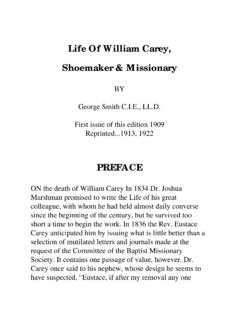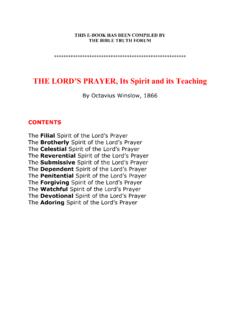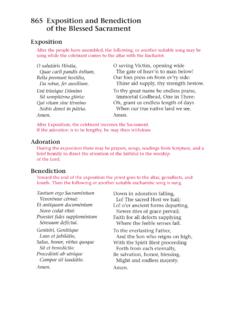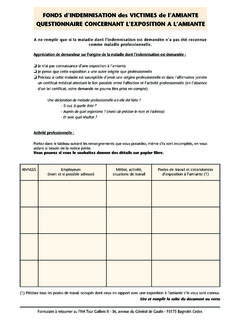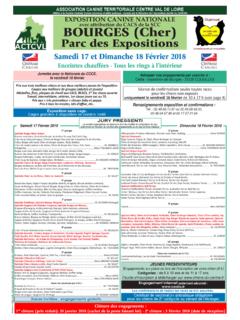Transcription of Exposition of the Gospel of John - Vol. 1 - Grace …
1 An Exposition of the Gospel of JOHNby PinkVolume OneJohn 1:1 7 Exposition of the Gospel of JOHNby PinkVolume OneJohn 1:1 7 is our purpose to give (D. V.) a verse by verse Exposition of the fourth Gospel in the course of this series of studies, but before turning to the opening verses of chapter I it will be necessary to consider John s Gospel as a whole, with the endeavor of discovering its scope, its central theme, and its relation to the other three Gospels. We shall not waste the reader s time by entering into a discussion as to who wrote this fourth Gospel , as to where John was when he wrote it, nor as to the probable date when it was written. These may be points of academic interest, but they provide no food for the soul, nor do they afford any help to an understanding of this section of the Bible, and these are the two chief things we desire to accomplish.
2 Our aim is to open up the Scriptures in such a way that the reader will be able to enter into the meaning of what God has recorded for our learning in this part of His Holy Word, and to edify those who are members of the Household of four Gospels deal with the earthly life of the Savior, but each one presents Him in an entirely different character. Matthew portrays the Lord Jesus as the Son of David, the Heir of Israel s throne, the King of the Jews; and everything in his Gospel contributes to this central theme. In Mark, Christ is seen as the Servant of Jehovah, the perfect Workman of God; and everything in this second Gospel brings out the characteristics of His service and the manner in which He served.
3 Luke treats of the humanity of the Savior, and presents Him as the perfect Man, contrasting Him from the sinful sons of men. The fourth Gospel views Him as the Heavenly One come down to earth, the eternal Son of the Father made flesh and tabernacling among men, and from start to finish this is the one dominant truth which is steadily held in we turn to the fourth Gospel we come to entirely different ground from that which is traversed in the other three. It is true, the period of time covered by it is the same as in Matthew, Mark, and Luke, some of the incidents treated of by the Synoptics come before us here, and He who has occupied the central position in the narratives of the first three Evangelists is the same One that is made pre-eminent by John; but otherwise, everything is entirely new.
4 The viewpoint of this fourth Gospel is more elevated than that of the others; its contents bring into view spiritual relationships rather than human ties; and, higher glories are revealed as touching the peerless Person of the Savior. In each of the first three Gospels Christ is viewed in human relationships, but not so in John. The purpose of this fourth Gospel is to show that the One who was born in a manger and afterward died on the Cross had higher glories than those of King, that He who humbled Himself to take the Servant place was, previously, equal with God, that the One who became the Son of Man was none other than, and ever remains, the Only Begotten of the book of the Bible has a prominent and dominant theme which is peculiar to itself.
5 Just as each member in the human body has its own particular function, so every book in the Bible has its own special purpose and mission. The theme of John s Gospel is the Deity of the Savior. Here, as nowhere else in Scripture so fully, the Godhood of Christ is presented to our view. That which is outstanding in this fourth Gospel is the Divine Sonship of the Lord Jesus. In this Book we are shown that the One who was heralded by the angels to the Bethlehem shepherds, who walked this earth for thirty-three years, who was crucified at Calvary who rose in triumph from the grave, and who forty days later departed from these scenes, was none other than the Lord of Glory. The evidence for this is overwhelming, the proofs almost without number, and the effect of contemplating them must be to bow our hearts in worship before the great God and our Savior Jesus Christ (Titus 2:13).
6 Here is a theme worthy of our most prayerful attention. If the Holy Spirit took such marked care to guard the perfections of our Lord s humanity- seen for example, in the words of the angel to Mary that Holy Thing which shall be born of thee, made in the likeness of sin s flesh, etc. equally so has the Inspirer of the Scriptures seen to it that there is no uncertainty touching the Divine Sonship of our Savior. Just as the Old Testament prophets made known that the Coming One should be a Man, a perfect Man, so did Messianic prediction give plain intimation that He should be more than a man. Through Isaiah God foretold, For unto us a Child is born, unto us a Son is given: and the government shall be upon His shoulder: and His name shall be called Wonderful, Counseller, The Mighty God, The Everlasting Father, The Prince of Peace.
7 Through Micah He declared, But thou, Bethlehem Ephratah, though thou be little among the thousands of Judah yet out of thee shall he come forth unto me that is to be Ruler in Israel; Whose goings forth have been from the days of eternity. Through Zechariah He said, Awake, O Sword, against my Shepherd, and against the man that is my Fellow, saith the Lord of Hosts: smite the Shepherd, and the sheep shall be scattered. Through the Psalmist He announced, The Lord said unto my Lord, Sit thou at my right hand, until I make thine enemies thy footstool. And again, when looking forward to the second advent, Thou art my Son; this day have I begotten thee (or, brought thee forth ). In these days of wide-spread departure from the faith, it cannot be insisted upon too strongly or too frequently that the Lord Jesus is none other than the Second Person of the blessed Trinity, co- eternal and co-equal with the Father and the Holy keeping with the special theme of this fourth Gospel , it is here we have the full unveiling of Christ s Divine glories.
8 It is here that we behold Him dwelling with God before time began and before ever the creature was formed (John 1:1, 2). It is here that He is denominated The only begotten of the Father, full of Grace and truth (John 1:14).It is here we read of John the Baptist bearing record that this is the Son of God (John 1:34).It is here that we read This beginning of miracles did Jesus in Cana of Galilee, and manifested forth his glory (John 2:11).It is here we are told that the Savior said Destroy this temple, and in three days I will raise it up (John 2:19).It is here we learn that The Father loveth the Son, and hath given all things into his hand (John 3:35).It is in this Gospel we hear Christ saying, For as the Father raiseth up the dead, and quickeneth them; even so the Son quickeneth whom he will.
9 For the Father judgeth no man, but hath committed all judgment unto the Son: that all should honor the Son, even as they honor the Father (John 5:21-23).It is here we find Him declaring, Before Abraham was, I am (John 8:58).It is here He affirmed I and my Father are One (John 10:30).It is here He testifies He that hath seen me hath seen the Father (John 14:9).Before we take up John s Gospel in detail, a few words should also be said concerning the scope of the fourth Gospel . It must be evident at once that this is quite different from the other three. There, Christ is seen in human relationships, and as connected with an earthly people; but here He is viewed in a Divine relationship, and as connected with a heavenly people.
10 It is true the mystery of the Body is not unfolded here that is found only in what the Apostle Paul wrote as he was moved by the Holy Spirit rather is it the Family relationship which is here in view: the Son of God together with the sons of God. It is also true that the heavenly calling, as such, is not fully unfolded here, yet are there plain intimations of it, as a careful study of it makes apparent. In the first three Gospels Christ is seen connected with the Jews, proclaiming the Messianic kingdom, a proclamation which ceased, however, as soon as it became evident that the nation had rejected Him. But here in John s Gospel His rejection is anticipated from the beginning, for in the very first chapter we are told, He came unto his own, and his own received him not.
